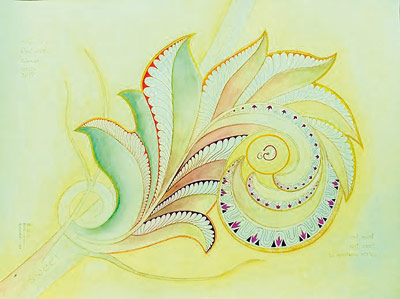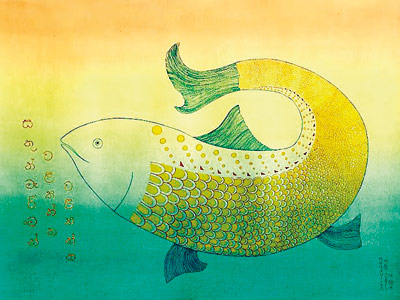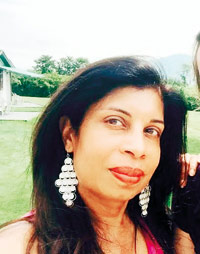The incredible transience of being
View(s):Mandalika Manjusri has long stepped out of the shadow of her father, the late scholar and artist Dr L.T.P. Manjusri, and is today established as an artist in her own right, with an ephemeral, spiritual and minimalist signature style that harks back to her roots in Buddhist temple painting.
Under her brush, nature, creatures, objects and events take on symbolism for a distinct philosophical narrative of life.
She tells Daleena Samara how the surrounding landscape, the present and past came into play in her new body of work created over a summer residency at Harwood Hill, Vermont, USA, this year.
- There were two exhibitions at Harwood Hill Motel and Cottages in Vermont, USA, one by popular demand. Tell us about them
It was a Summer Residency in Vermont that extended from end of May to early October 2015. Vermont is famous for its stunning rivers, lakes and forests.
Although their fall colours are legendary, in summer, the rolling hills carpeted in emerald green act like an oasis. You are humbled by nature, which pretty much transcends everything else!
The state has produced and influenced many artists and poets such as Robert Frost, Rudyard Kipling, Norman Rockwell and Grandma Moses.
All were inspired by the pristine natural beauty and Vermont’s ability to provide isolation and space to create.
Three distinct phases emerged from the residency. The first was an exhibition titled From the Caves to the Contemporary two months into the programme.
It was a huge success and, later, there was a repeat, by demand from those who missed it. The mural was executed in the final phase. Pamela Corkey, founding owner of Harwood Hill and a film professor from Hofstra University, curated the shows.
Fascinated by the continuing evolution of the storyline, she established a timeline from the beginning until current times of my artistic career.
The exhibition spanned the period apprenticing with father, later engaging in family projects with my two siblings Kushan and Manjista at the new Parliamentary complex, documenting the Dambulla cave paintings etc, and trailed off with works produced for the UN exhibition a couple of years ago.
It intrigued Bennington’s progressive artistic community. New works were included in the second show because I continued to produce while there.
When I retreated to my studio at night, I would look forward to sitting out on the porch in the morning, feasting my eyes on the not-too-distant blue mountains, taking in the glorious sky strewn with clouds, and the birds chanting in my ears.
With only a few soft deadlines thrown in my direction and practically left alone, it became a perfect world to create.
- So the paintings reflect Vermont, your mood and social issues you were touched by or that occurred around you?
Generally, the works reflect the curiosity or the fascination with an image or object and the mood with which it is being received.
The outcome is how the two play out together in the arena called the mind! The fabulous weeping willow sweeping the gardens of Harwood Hill inspired Dancing Willow.
Around that time, I was also visiting a dear old friend and he showed me all there was to see in Vermont. My mood full of joy and celebration manifested in the paintings and I saw the tree dancing to Krishna Das’s devotional Kirtan music, instead of “weeping”!
Vermont’s abundance of rivers, lakes and excess water had me drawing fish. Mute Fish was created during the time Cecile the Lion was killed.
The non-verbal message from the fish is “refrain from killing animals which is simple and powerful, signifying the need for mutual respect and harmony. Working on the minute details was meditative and I was transported to another dimension.
The Mind has a kind of a broken head sticking out of a human torso with a noose around the neck and four labels attached: Race, Religion, Sexual Orientation, and Gender.
The huge veil enveloping part of the head repeats the word “cleanse” like a mantra. Fingers point at institutions, schools, customs and traditions that teach. But it’s all in the mind.
Tension and conflict prevalent in society can only be eased by unscrambling what has already being taught and practised. Hence The Mind.
- Your own minimalist style emerged much later. Which year was your first exhibition?
Though I loved my father dearly, I was getting a bit tired of being called “Manjusri’s daughter”. At one point, Barbara Sansoni took me under her wing.
That was a new beginning. I began experimenting first through textiles as a designer for Barefoot and later with my paintings. The minimalism began to emerge I guess in rebellion against the massive and intricate detail characteristic of temple painting.
It was a welcome departure; a relief almost. I started enjoying incorporating as few lines as possible and indulging in the abstract — a sort of distortion of the real world and venturing into the magical, the way I see it or the way I would like to see it.
I also experimented with soft pastel colours as opposed to the dramatic bold colours initially used in temple paintings. By 2000, my works were very well received and I was invited to participate in many exhibitions locally and internationally.
I was happy to have established an identity of my own while remaining loyal to my family tradition of documenting mural painting, which I honour and cherish.
It was like a new-found freedom. Today, I feel I’m indulging in increasing detail in my art or combining minimalism with intricacy or infusing complexity into my minimalist ideas! So, in a sense, I may be going back to details, or enjoying it in a different way.
- Apart from Buddhist art, did any other artists influence your style?
I have always been fascinated by the human mind — the conscious and the unconscious. Joan Miro, Marc Chagall, Paul Klee and Henri Matisse are among my favourites.
I like their works because of the nonconformity and absence of control exercised by reason, which could be called the dictation of thought.
I like the idea of non-sequential matter connecting philosophy, political thought and social theory. I believe this need for the unconscious to express itself results in liberating the imagination.
The more distant is the relationship between two juxtaposed realities, the stronger the image will be and the greater its emotional power and poetic reality. It frees people from false rationality, and restrictive customs and structures.
- Your works are somewhat philosophical: would that come from your father’s influence?
Indeed father was very loving and philosophical on so many levels and this would have paved the way for us to mature and understand life early.
I guess it also comes naturally for me, which could mean that it’s just the way I look at things! Every emotion or object in life within and around you is subject to change every second of the day.

Mandalika Manjusri
Even pain or suffering changes just as much as happiness. It’s an illusion to think that any given single thing is permanent, which is exactly what we seek!
- What you say about impermanence sounds like the Buddhist concept of emptiness?
All phenomena are impermanent and in a constant state of flux and so impermanence and change are undeniable truths of existence.
What is real is the existing moment, the present that’s a product of the past or a result of previous causes and actions. Due to ignorance, we conceive them to be part of one continuous reality.
In this realm of change, nothing takes on a fixed identity. Everything is interrelated and an expression of the ever-changing landscape of change — always shifting, changing, evolving.
The non-clinging mind could see the transient nature of what we try desperately to cling to.
- You include script in your work
Texts have been used in art from ancient to modern times, in countries and cultures that are in constant friction, for example, Arabic, Tamil, Hebrew, Hindi, Sinhala, English, French and Brahmi.
As part of the Cartographic Unit of the Postgraduate Institute of Archaeology, University of Kelaniya, during the time of late Prof. Senake Bandaranayake, I loved doing maps, and this resurfaces from time to time.
But it’s the first time it has been incorporated into my works. It’s the merging of the ancient with the modern, the past with the future.
- Your imagery is stylized and seems influenced by Buddhist art
Mapul, the ancient word for “maple”, was inspired by my intense curiosity about the maple trees that grow in abundance in Vermont.
Photographs cannot do justice to the startling scarlet, birch gold, purples and oranges that blaze across the hills and valleys in fall when “leaf peepers” come flocking to see the fall foliage!
Mapul became a platform to blend aesthetics and culture, infused with multiple languages, the need to respect and conserve nature and, finally, evolved into a motif from a Sri Lankan temple mural.
Anguish was born of utter curiosity about the form and shape of Vermont.
The painting reflects its 14 counties, the Brahmi script signifying knowledge leads to goodness, peace and victory, the rivers indicate the excess amounts of water it naturally produces, and finally becomes an Easter Island head smoothly gliding across.
- Please comment on your choice of media and size
Though handling large scrolls of paper when documenting temple paintings is and has always been a part of me, when it comes to my own works, I gravitate towards medium sizes rather than too large or too small.
The mediums used mostly have been water and acrylics on paper, while watercolour allows a sense of transparency, acrylics do exactly the opposite. The textural feel of the paper paves the way to hone one’s sensibilities.
- Tell us about the mural and poem?
Harwood Hill is set on the hillside with apple orchards on one side and mountains on the other. The works of various artists are spread across its gardens, so I wasn’t surprised when Pam showed an interest in commissioning a mural.
After a lot of discussion about the location, we chose a spot close to the road that could be seen from miles away. The exterior wall covered in wood shingles, five windows, a brick red door, and another crimson door, had me thinking.
It was already very busy! So I wanted the mural to be as simple as possible, incorporating all the elements.
The inspiration came from way back, from my friend’s dog Bobo, a wise old labrador whom I adored. I had a particularly endearing impression of him seated sometimes in the kitchen looking from me to the cookie jar on the counter and back at me, with a subtleness you wouldn’t perceive if you didn’t know him well.
This impression somehow got transformed into a more universal message where Bobo became a rabbit and the cookie jar the moon.
While Harwood Hill is run by a group of very special artists and individuals, it’s safe to say that it’s totally owned by the rabbits who live underground.
Meanwhile, moon gazing is a common pastime on an evening around a bonfire. I wasn’t content with the mural, and so I wrote a poem about it — to pay tribute to Bobo! That’s how I fell in love with Vermont and became a “Vermont outsider artist”.
To all dreamers and others
Welcome to the Rabbit Haven of Harwood Hill
When it comes magically alive mainly at dawn and at dusk.
Especially, when the moon bids either “hello” or may be even “goodbye”.
They emerge from the maze of underground tunnels and burrows
To graze the luscious green grass on top
With their bright white cotton tufts sticking out from behind.
Meanwhile a sublime dog named Bobo living below the great Obelisk
Is gazing at the cookie jar sitting still on the kitchen counter
And dreaming of getting maybe just one more cookie!
Bobo joins hands with the rabbit world of Bennington
To spread their sweet energy throughout the universe and far beyond …


